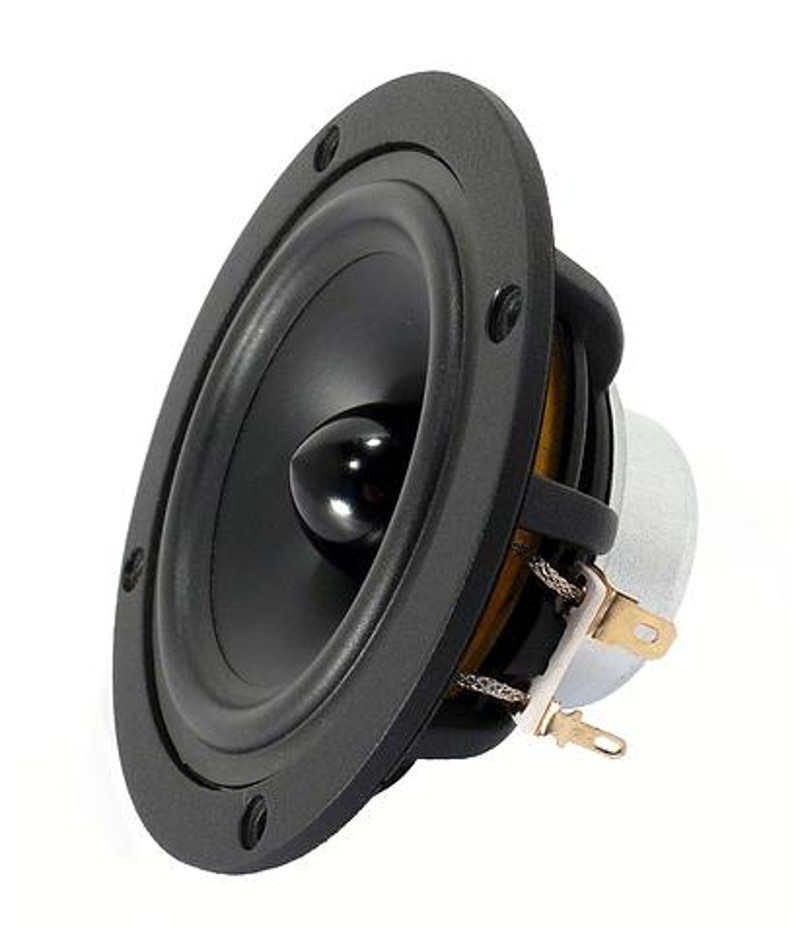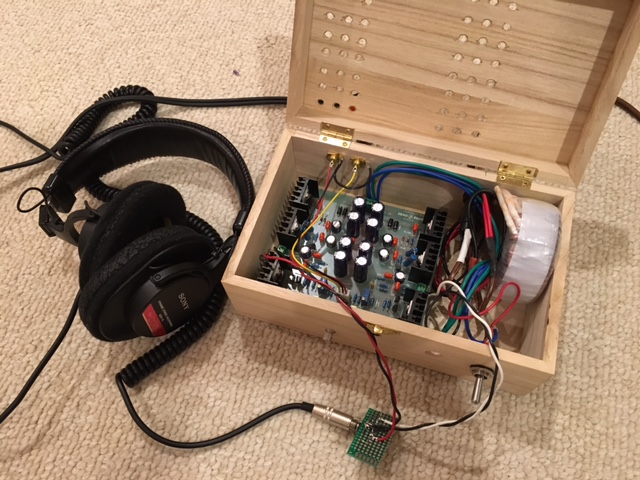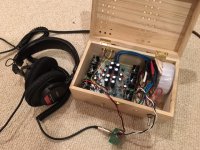I have been building speaker projects for years but now I want to build my own headphones from scratch. However, I am not sure if the same principles would apply. I really want to make something unique completely from scratch and not use existing headphone drivers (this is the same as buying already known headphones).
What I'd like to do is use a 3" full range woofer from Mark audio and position the driver inside cups so that it is roughly 1" from the year. Would this work or sound good?
Finally, how do I make sure that I get a flat frequency response from the highest to the lowest frequencies?
Any help would be much appreciated. Thanks guys!
What I'd like to do is use a 3" full range woofer from Mark audio and position the driver inside cups so that it is roughly 1" from the year. Would this work or sound good?
Finally, how do I make sure that I get a flat frequency response from the highest to the lowest frequencies?
Any help would be much appreciated. Thanks guys!
In addition, can anyone share some insight into how headphone manufacturers create a driver that has a completely flat frequency response at the ear but in a totally passive device without the use of any passive or active crossovers or equalization? I am curious how Senheiser gets such deep bass and extended high all from a single driver without anything else added to manipulate the response?
Instead of full-range, why not...
use drivers designed for headphones instead? If you search the electronics sites for 40mm speakers you'll find at least several of various impedance. These are the raw drivers (and fwiw are often identical to those used by some "name" brands.) Like this.
There are threads that discuss the merits of small drivers vs full range.
Good luck and keep us posted on what you decide to do.
use drivers designed for headphones instead? If you search the electronics sites for 40mm speakers you'll find at least several of various impedance. These are the raw drivers (and fwiw are often identical to those used by some "name" brands.) Like this.
There are threads that discuss the merits of small drivers vs full range.
Good luck and keep us posted on what you decide to do.
seriously?
You respond to a post on a DIY forum, and tell someone not to bother DIY'ing and buy a commercial headphone instead?
I wouldnt bother, just get hd600/650 or k701, or beyer somtheing and be done with it.
You respond to a post on a DIY forum, and tell someone not to bother DIY'ing and buy a commercial headphone instead?
Thanks guys. In particular, I am trying to understand the physics behind the operation of a headphone driver. In the suggested thread above, several people recommend just using a full range 2" woofer from Aura or something similar. But this would not result in a flat frequency response.
Can someone explain how a headphone driver is made by Senheiser and others so that it has a completely flat response at the ear without any equalization? It is fascinating to me how a single small driver can be flat down to 20Hz simply by the construction of the cone and voice coil. How is this possible?
Can someone explain how a headphone driver is made by Senheiser and others so that it has a completely flat response at the ear without any equalization? It is fascinating to me how a single small driver can be flat down to 20Hz simply by the construction of the cone and voice coil. How is this possible?
Thanks guys. In particular, I am trying to understand the physics behind the operation of a headphone driver. In the suggested thread above, several people recommend just using a full range 2" woofer from Aura or something similar. But this would not result in a flat frequency response.
Can someone explain how a headphone driver is made by Senheiser and others so that it has a completely flat response at the ear without any equalization? It is fascinating to me how a single small driver can be flat down to 20Hz simply by the construction of the cone and voice coil. How is this possible?
Headphone drivers have very different requirements: they only need to generate a fraction of the SPL as they are less than an inch from the ear so use low powers and very small cone excursions. Designing a full range driver for this probably precludes many of the requirements needed by speaker drivers which have to generate a lot more sound power. Also, headphone drivers are higher impedance (32 ohms to 600 ohms) and use fine wire windings, very low mass cones, etc. I think starting with a good 2 in dia full range driver that is fairly flat and adding a 24 ohm resistor to get it to 32 ohms may work as you don't need a lot of SPL. It may measure flat due to the very low cone excursion and how close the mic is. Give it a try. My in ear monitor headphones are rated at 114dB at 1mW ! That is about 1 million times more "efficient" than a regular 94dB driver when required to push similar levels in open air at 1m.
Tyll's stuff
Audioari, if you haven't already seen this, Tyll Hertsens has written some excellent guides to headphone response and measurement (at Headroom and InnerFidelity.) He also has data sheets for many headphones with test results including frequency response.
Downloading the data sheets for some world-class brands/models and using his guidelines to interpret them is a nice way to see how Sennheiser, AKG, Beyer, Audeze, etc actually perform. One noticeable thing is that although some do better than others, none have a ruler-flat frequency response.
Audioari, if you haven't already seen this, Tyll Hertsens has written some excellent guides to headphone response and measurement (at Headroom and InnerFidelity.) He also has data sheets for many headphones with test results including frequency response.
Downloading the data sheets for some world-class brands/models and using his guidelines to interpret them is a nice way to see how Sennheiser, AKG, Beyer, Audeze, etc actually perform. One noticeable thing is that although some do better than others, none have a ruler-flat frequency response.
not to mention the weight of a regular driver. most headphones weight 500g and less, dont know how to pull this off really.Headphone drivers have very different requirements: they only need to generate a fraction of the SPL as they are less than an inch from the ear so use low powers and very small cone excursions. Designing a full range driver for this probably precludes many of the requirements needed by speaker drivers which have to generate a lot more sound power. Also, headphone drivers are higher impedance (32 ohms to 600 ohms) and use fine wire windings, very low mass cones, etc. I think starting with a good 2 in dia full range driver that is fairly flat and adding a 24 ohm resistor to get it to 32 ohms may work as you don't need a lot of SPL. It may measure flat due to the very low cone excursion and how close the mic is. Give it a try. My in ear monitor headphones are rated at 114dB at 1mW ! That is about 1 million times more "efficient" than a regular 94dB driver when required to push similar levels in open air at 1m.
Last edited:
Thats the point, I am trying to understand the difference between a headphone driver and a small full range woofer (say a 2" aura driver). What makes a full range woofer different? What is done to a dedicated headphone driver to make it sound good when its close to the ear?
Reviving an old thread here. I have tons of nice 3in, 2.5in and 3.5in full range drivers. I just built a really nice class A headphone amp capable of driving an 8ohm load at 1.6w. It can power room speakers even. Anyhow, I was thinking maybe a nice full range when used open back can give an open transparent sound with pretty deep bass as they wont be required to move much air. I am thinking of a Visaton B80 in particular as it has a nice looking cast open basket. I would need to 3D print a "baffle" that attaches to the bezel of the driver and provides a cushioned ear rest and then print or repurpose the headband and hinge mechanism from a low cost pair of headphones. I realize these may be a bit heavy (a Nd magnet helps to keep weight down).
Side view of B80:

I listened to my new JLH class A headamp last night on old Sony MDRV6's and the sound quality was a revelation. Never heard such deep deep bass before and never heard such detail and low noise clarity in these phones before.
Here is the amp almost finished awaiting a 1/4in jack.

Side view of B80:

I listened to my new JLH class A headamp last night on old Sony MDRV6's and the sound quality was a revelation. Never heard such deep deep bass before and never heard such detail and low noise clarity in these phones before.
Here is the amp almost finished awaiting a 1/4in jack.

Attachments
Last edited:
- Status
- This old topic is closed. If you want to reopen this topic, contact a moderator using the "Report Post" button.
- Home
- Loudspeakers
- Full Range
- How to DIY headphones with full range woofer??
